Since Ukraine gained independence in 1991, most of its society was in a state of anomie, a dark state that produces apathy, detachment and a lack of moral compass. With Russia’s full-scale war, this has now changed for the first time: 48% of Ukrainians now believe that generally accepted norms do exist, more than those who do not, a recent survey by the Rating sociological agency has found.
Anomie, a state in society when old moral values have been broken down and new ones not yet formed, prevailed in Ukraine after the collapse of the USSR and the breakdown of the Soviet system and ideology, as well as the economic foundations of society. This social condition, which occurs during and follows periods of drastic and rapid changes to the social, economic, or political structures of society, produces people who typically feel hopeless and disconnected, and is thought to lead to a breakdown of society and thus elevated deviance and crime.
Until now, Ukraine has been wallowing in such a state of anomie, with the condition peaking in the 1990s, marked by “wild” capitalism in which poverty skyrocketed and the transition to a market economy suddenly left swaths of people homeless.
However, eight months into full-blown war, Ukrainian society was characterized by a nearly equal number of those who believe there are no generally accepted/recognized norms in our society (anomie) and, on the other hand, those who believe that such norms do exist (non-anomie). The proportion of the first category of respondents is 46%, while the proportion of the second category is 48%. The remaining 6% of respondents fall into the intermediate category. Although, it is challenging to infer the latter category’s perspective on the existence of generally accepted social norms.
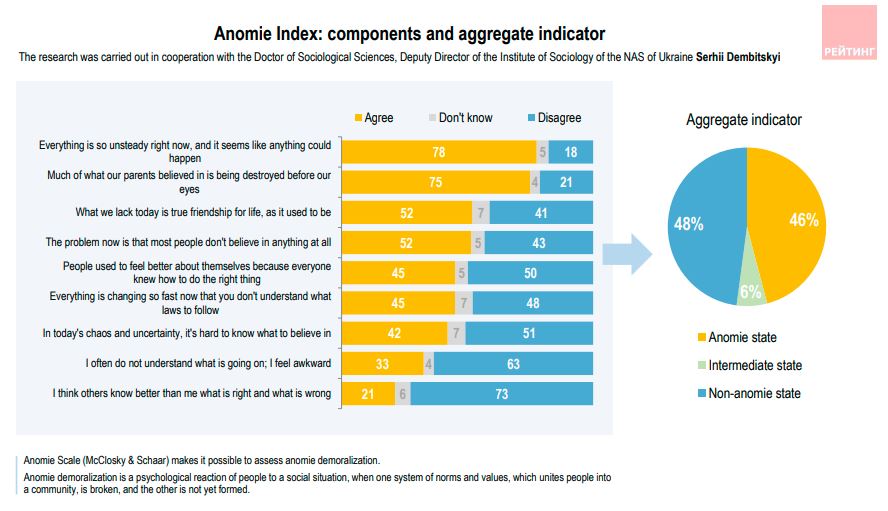
Throughout modern Ukraine’s history, anomie has dominated Ukrainian society. It has gradually and unevenly waned (from 82% in 1992 to 72% in 2022). However, since the start of Russia’s large-scale war against Ukraine in early 2022, anomie sentiments have significantly decreased and ceased to be decisive, despite remaining quite widespread.
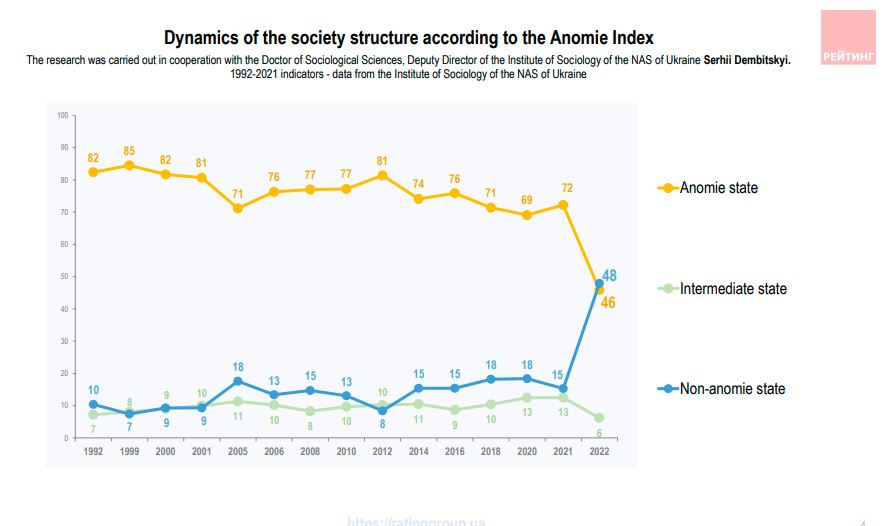
Uncertainty about the future and a sense of the annihilation of their parents’ beliefs are the key indicators that still point to the existence of anomie attitudes among the respondents. These observations are entirely consistent with the logic of what is currently taking place in Ukraine. Simultaneously, the majority of respondents fully comprehend what is occurring around them. The respondents are also confident in their evaluations of what is currently valid and false.
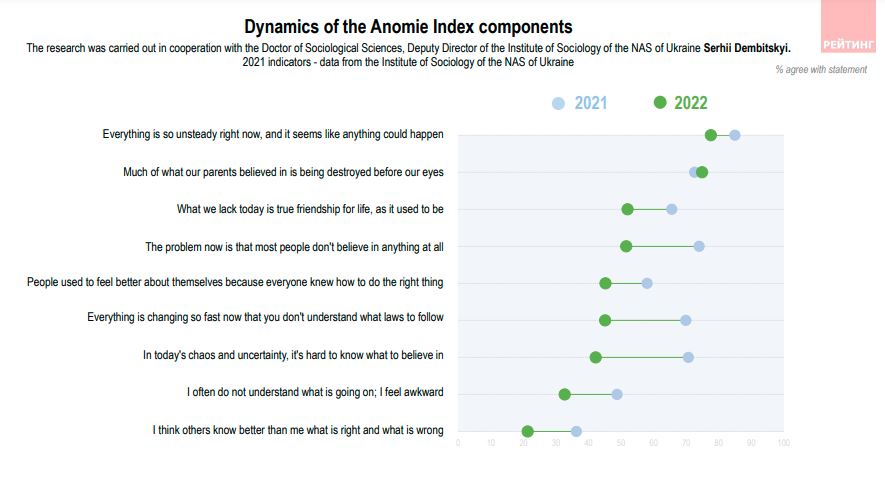
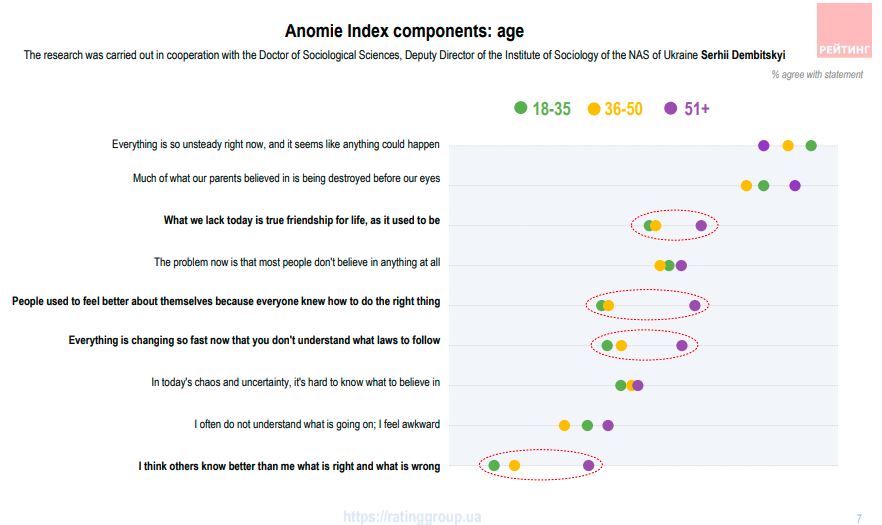
Regarding the state of anomie, there are virtually no regional differences among the respondents. Although the following differences are present between the residents of various settlement types, age groups, and genders:
- 1) As the size of a settlement increases, the prevalence of anomie decreases;
- 2) Anomie becomes more prevalent with age;
- 3) Anomie is more prevalent among men than women.
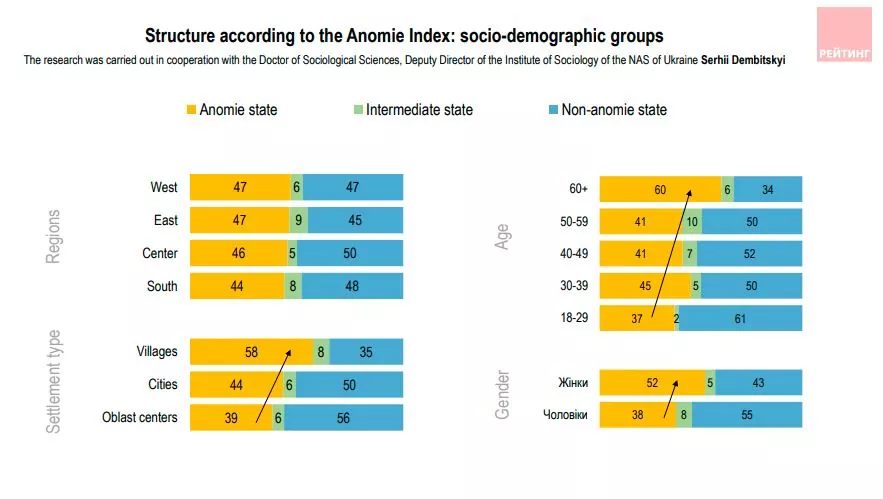
The Anomie Scale (McClosky & Schaar 1965) allows for the evaluation of anomie demoralization. Anomie demoralization is the psychological response of individuals to a social situation. In this situation, one system of norms and values that binds individuals into a community has been broken, and the other has not yet been established.
Dates of the survey: 20-21 November
The sociological group “Rating” conducted the study in collaboration with Serhii Dembitskyi, Doctor of Sociological Sciences and Deputy Director of the Institute of Sociology at the Ukrainian National Academy of Sciences.
Target population: Ukrainians aged 18 and up in all oblasts. It excludes the temporarily occupied by Russia territories of Crimea and Donbas, as well as territories with no Ukrainian mobile network at the time of the survey. The outcomes are weighted using the most recent data from the Ukrainian State Statistics Service. The sample is representative concerning age, gender, and type of settlement. The sample size: was 1000 respondents. Survey method: Computer-Assisted Telephone Interviewing (CATI). Based on a representative sample of mobile phone numbers. With a confidence interval of 0.95, the study’s margin of error does not exceed 3.1%.





